

Researched-Based Strategies. Related Classroom Examples Owning Goals Creating personal learning goals supports literacy.
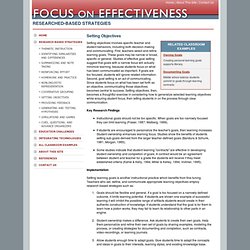
Documenting Goals Middle school science students commit to goals through learning contracts. Setting Objectives Setting objectives involves specific teacher and student behaviors, including both decision-making and communicating. Key Research Findings Instructional goals should not be too specific. Implementation Setting learning goals is another instructional practice which benefits from fine-tuning. Goals should be flexible and general. Additional Resources The North Central Regional Educational Laboratory publishes an online resource entitled Pathways to School Improvement.
Generating and Testing Hypotheses. Related Classroom Examples Investigating Hypotheses Applying the scientific method high school students use technology to help frame science investigations.
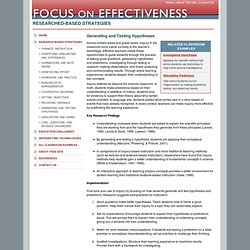
Stimulating Predictions High school students correct misperception by making predictions, testing, and observing results. Generating and Testing Hypotheses Across content areas and grade levels, inquiry in the classroom turns native curiosity to the learner's advantage. Inquiry extends far beyond the science classroom. Key Research Findings Understanding increases when students are asked to explain the scientific principles they are working from and the hypotheses they generate from these principles (Lavoie, 1999; Lavoie & Good, 1988; Lawson, 1988). Implementation. Researched-Based Strategies. Related Classroom Examples Messaging Shakespeare Summarizing complex texts using cell phones increases understanding.
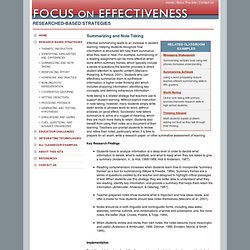
Summarizing Software Using a word processing feature teaches efficient summarizing skills to fifth-graders. Worth Noting Online note taking with primary sources improves research skills in high school students. Thinking Allowed Math students explain problem-solving out loud as they talk through their thinking. Summarizing and Note Taking Effective summarizing leads to an increase in student learning.
Note taking is a related strategy that teachers use to support student learning. Researched-Based Strategies. Related Classroom Examples Revolutionizing Chat Using Internet relay chat to focus practice while studying the French Revolution.
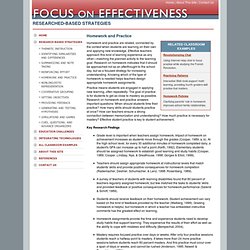
Practicing Patterns Interactive Web tools support math learning, providing fourth-graders skill practice that matters. Homework Policies Clarifying parents' role in homework improves school-family relationships. Cues, Questions, and Advance Organizers. Related Classroom Examples Charting The News High school students use Web-based news services to view, explore, and chart current events.
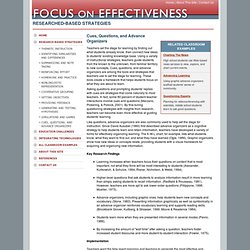
Advancing Learning Using graphic advance organizers scaffold students' sense of community. Questioning Experts Planning for videoconferencing with scientists, middle school students learn to ask good questions. Cues, Questions, and Advance Organizers Teachers set the stage for learning by finding out what students already know, then connect new ideas to students' existing knowledge base.
Asking questions and prompting students' replies with cues are strategies that come naturally to most teachers. Like questions, advance organizers are also commonly used to help set the stage for instruction. Key Research Findings Learning increases when teachers focus their questions on content that is most important, not what they think will be most interesting to students (Alexander, Kulikowich, & Schulze, 1994; Risner, Nicholson, & Webb, 1994).
Implementation. Researched-Based Strategies. Related Classroom Examples Guiding Cooperation Teacher turns to technology to guide cooperative learning in a blended fourth-fifth science class.

Collaborative Writing Middle school students polish skills for writing, reflection, and collaboration. Cooperative Grouping Cooperative learning is actually a generic term that refers to numerous methods for grouping students. Students understand that their membership in a learning group means that they either succeed or fail—together. Key Research Findings Organizing students in heterogeneous cooperative learning groups at least once a week has a significant effect on learning (Marzano, Pickering, & Pollock, 2001).
Implementation Grouping students to work collaboratively and cooperatively offers benefits for learners. Create the right type of group for the need. Additional Resources. Nonlinguistic Representation. Related Classroom Examples Choreographing Math Building understanding in an arts-infused middle school class.
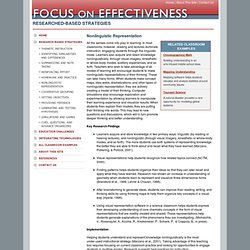
Mapping Understanding Mapping software helps students visualize and analyze statistics around community issues. Tsunami Science A natural disaster provides a rare opportunity for modeling global systems. Nonlinguistic Representation All the senses come into play in learning. Key Research Findings Learners acquire and store knowledge in two primary ways: linguistic (by reading or hearing lectures), and nonlinguistic (through visual imagery, kinesthetic or whole-body modes, and so forth). Implementation Helping students understand and represent knowledge nonlinguistically is the most under-used instructional strategy (Marzano et al., 2001). Model use of new tools. Additional Resources The Council for Exceptional Children provides a bibliography and resources about graphic organizers. Carleton College publishes a Web site about teaching with visualization. Identifying Similarities and Differences. Related Classroom Examples Imagining Change Images help set the stage for understanding abstract concepts.
Magnifying Learning Young English language learners talk about the world using hand lenses. Learning Categories Sixth-graders reflect on and categorize traits of successful learners. Identifying Similarities and Differences Seeing similarities and differences is a fundamental cognitive process (Gentner & Markman, 1994; Medin, Goldstone, & Markman, 1995). Key Research Findings Cognitive research shows that educational programs should challenge students to link, connect, and integrate ideas (Bransford, Brown, & Cocking, 1999).
Implementation Students benefit by direct instruction and open-ended experiences in identifying similarities and differences. Additional Resources The Private Eye is a resource for teaching students how to use metaphor, and compare and contrast, through the use of jeweler's loupes and focused questioning. Marzano's Instructional Strategies.